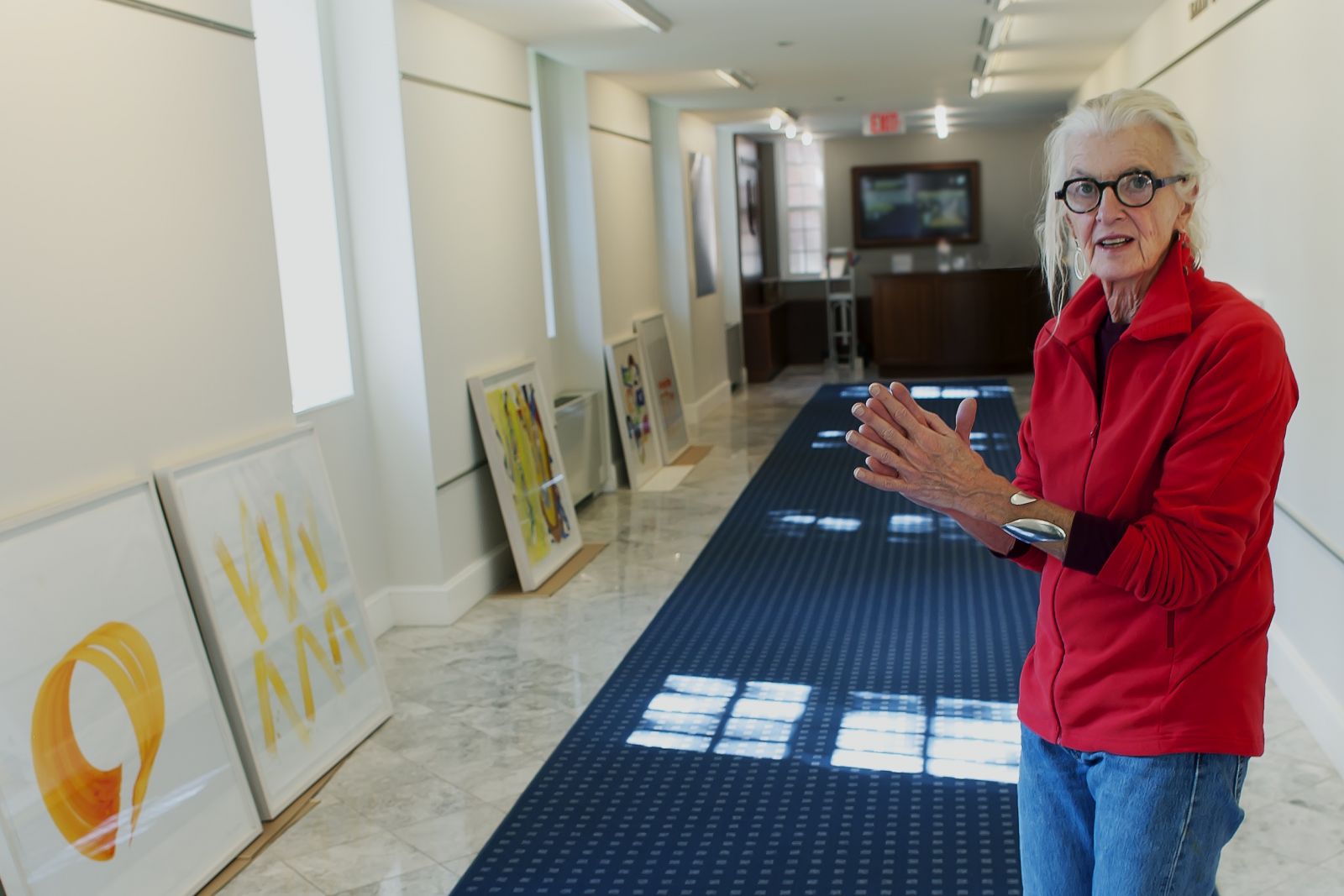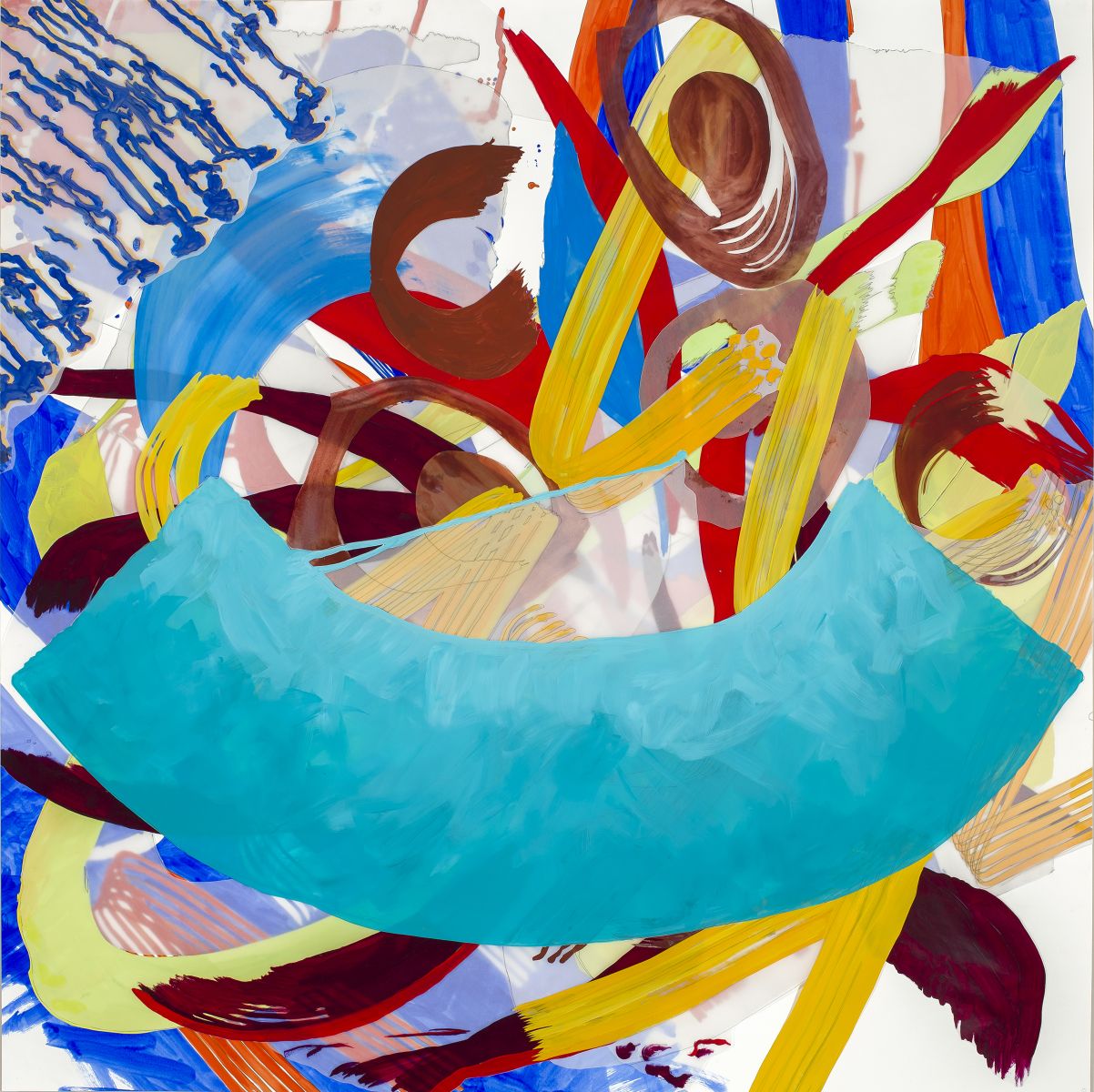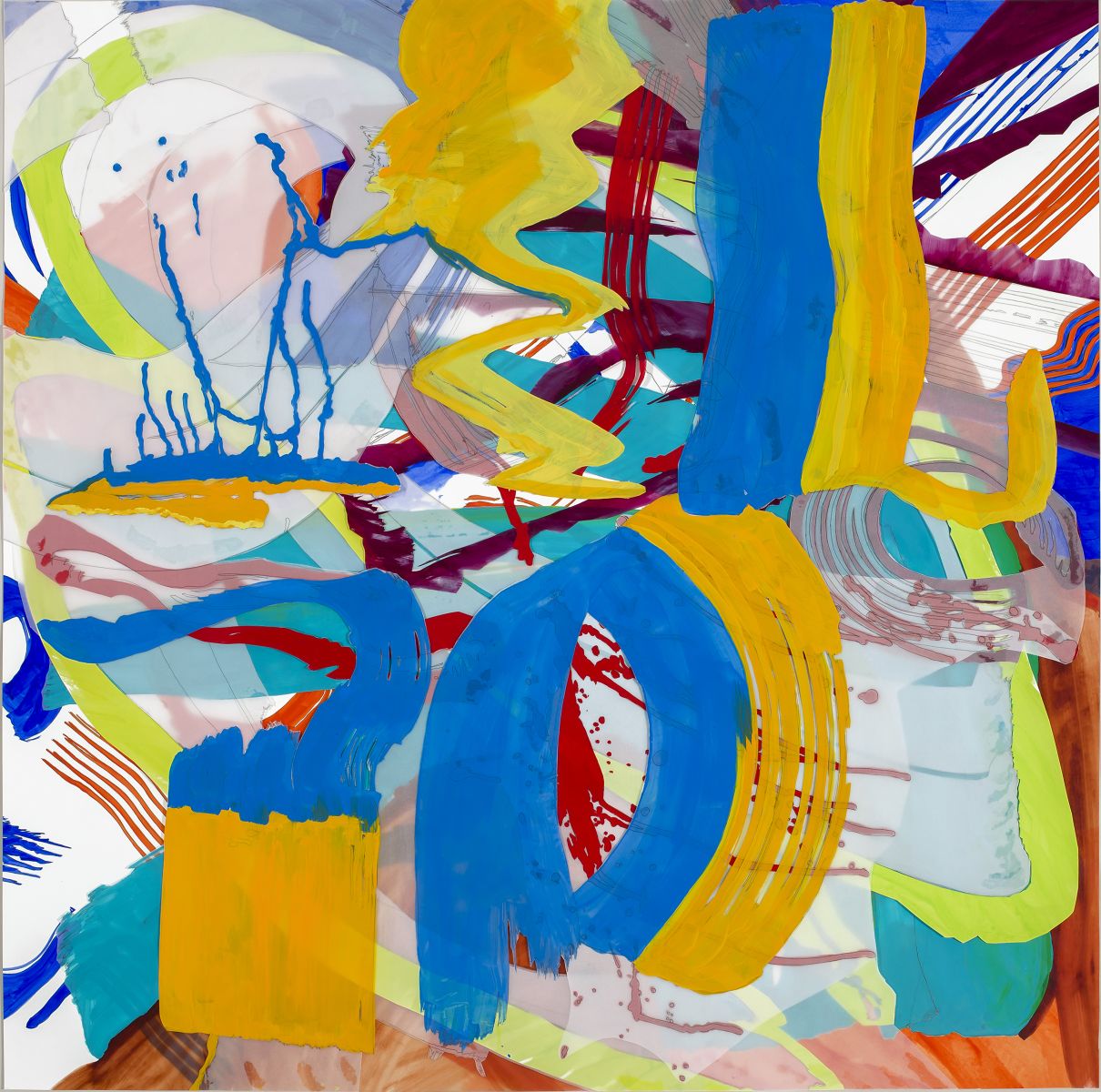By Timothy Cahill ’16 M.A.R.
We had just begun our interview when artist Ellen Priest ’77 M. Div. interrupted the conversation. “Hang on,” she said over the telephone. “I’m going to turn my music off.”
“What were you listening to?” I asked Priest when she returned.
 “A jazz CD by Paquito D’Rivera and Roy Hargrove”— the Cuban saxophonist and African-American trumpeter.
“A jazz CD by Paquito D’Rivera and Roy Hargrove”— the Cuban saxophonist and African-American trumpeter.
Um-hmm, I thought to myself. Perfect.
I had called Priest at her Delaware home and studio to talk about the exhibition of her paintings on display at Yale Divinity School through January 25, 2023. The show, Jazz Cubano: Color Improvisations, is inspired by the emancipated energy and rhythmic complexity of Afro-Cuban jazz, with its interlaced influences of Africa, Europe, and the Americas.
Jazz has been Priest’s artistic inspiration for more than 30 years. “Just as some people paint mountain landscapes, I paint jazz,” she explained to WHYY-TV in 2018. But, of course, it’s not that simple. Depicting the physical presence of a mountain, she admits, is “light years” away from capturing with brush and pigment the transient, intangible, ever-shifting soul of jazz.
It was a challenge and calling that came to her in 1990. Before then, Priest had been producing the kind of emotive, abstract canvases that people think of as “modern” painting. After more than a decade of that, though, she’d begun to feel her inspiration drying up.
“I needed fresh material that was outside myself,” she recalled. The painter’s search for the muse ended the night the car radio came on with a piece by Dominican jazz pianist Michel Camilo. The music triggered a eureka moment, and she knew she’d found her purpose—subject matter that “described and embodied the spaces and movement” she had in her imagination. She began buying jazz recordings and related music by Brazilian and Afro-Cuban composers, making brush studies of how their percussive, upbeat sound made her feel. A first series of paintings emerged in 1993; a second four years later.
To get there, Priest developed a practice that went beyond private emotional response. In this, she was aided by the music that filled her tightly disciplined Presbyterian childhood in Duluth, Minn. Her grandmother was the organist for a church, and her parents often had records playing—classical, jazz, and popular tunes. Her father loved Louis Armstrong.
“I had eight years of forced music lessons, piano and flute, and I never made any music I liked,” she explained. “But I did learn to read music, and that’s payed off in my artwork.” She has adapted what she learned into a technique for building paintings.
The process is intricate. She begins by painting brush studies in a specialized vinyl gouache, always listening to the source jazz recording. Next, working from the music’s written score, she plots the rhythms of chosen measures as coordinates on a sheet of paper the size of the final painting, and lightly pencils a grid of parallel vertical or diagonal lines. This grid becomes the framework for positioning the studies in a process she likens to choreography, “sometimes rational and mathematical, other times utterly intuitive.”
The result is an “underpainting” of free-form arcs and waves, swoops, knots, squiggles, and scratches in complementary and competing colors.
Priest then builds on this base layer, adding additional oil color passages on overlays of translucent paper. Some of these new forms follow the original grid; others emerge by surrendering to a deeper intelligence, plying her paint-laden brush like a jazz musician, following no path except the one she sees and feels.
“I describe it as improvising,” said Priest, “though I don’t know that there is a good way of describing it verbally. This is a language of visual art and music. There’s no verbiage involved.”
She went on: “The funny thing is that the process in certain ways feels very restrained. But when you get such a build-up of rhythm and color and sound, even though each element by itself is carefully structured—even improvisation has rules—it builds into something that has the potential to be explosive. All this semi-restrained energy put together really releases.”
For the uninitiated, in her exhibition statement Priest offers advice on how to look at the work.
“If I could say one thing to a person viewing my paintings for the first time, it would be, ‘Give them time to move,’” she writes.
Stay with them and the paintings reveal themselves. You see they are not flat surfaces at all, but built up in three, four, as many as five layers—the gouache and pencil base, the translucent middle layers of linework and polyphonic brushwork, with colored paper fragments collaged throughout. They move not just laterally across the surface, but dimensionally, from front to back.
What is true of all artwork applies especially here—reproductions don’t do the paintings justice. They have to be seen firsthand. For the artist, her work’s purpose is fulfilled only when others have shared its exuberance.
 “Jazz evokes in me what I want my artwork to evoke in the viewer—joy, energy, inspiration,” she explained. “If it never leaves my studio, it’s incomplete.”
“Jazz evokes in me what I want my artwork to evoke in the viewer—joy, energy, inspiration,” she explained. “If it never leaves my studio, it’s incomplete.”
Priest has exhibited her work extensively in venues ranging from art museums to churches. In 2012, the Institute of Sacred Music hosted an exhibition of her work that covered the YDS walls, when the ISM was still located within the School’s main building. The current show, in the Sarah G. Smith Gallery, was planned for the spring of 2021, but delayed by the pandemic.
Beneath the surface of these animated, complex artworks lies a long personal quest, one profoundly shaped by Priest’s experience at YDS. In the conversation below, she describes the journey she took to become an artist, and the key role Yale played on that path. The transcript has been edited for length and clarity.
Timothy Cahill: You’ve said your father was the first major influence in your life. How so?
Ellen Priest: The Priest family is full of doctors and engineers. My uncle was the doctor and my dad was going to be the engineer. In 1931, he abandoned a master’s degree in mechanical engineering because of the Depression and joined his father’s business. My grandfather had the first automobile dealership in that region. He started with Ford in the ’20s. So, Dad went into that business, because he was lucky to have anything, and stayed there.
He believed that I could do whatever I set out to do. For a girl growing up in northern Minnesota in the 1950s and ’60s, that was remarkable permission to get from a father. When I was 14 years old, he sat me down and told me, ‘Ellen, you have to do what makes you happy. If that’s digging ditches, then go dig ditches.’ He knew that it flew in the face of all the intellectual, professional pressure I was getting from everywhere, including my mother. I was a straight-A student, you know—I did all the right stuff. But from my father, I got the idea that it was very important that I was happy in what I was doing. I think that was, in a way, an autobiographical comment on his part, because he’d wanted to be an engineer, and the Depression took that from him.
Was he creative at home? Did you see that side of him come out in ways that weren’t necessarily about earning a living?
He was creative in an engineering sense. He loved fixing engines, any mechanical problem. It’s not creativity in the sense of the fine arts—not making symbolic form, which is what art, music, and literature are—but was he creative in everything that he did? Yes.
After high school, you went to Lawrence University [in Appleton, Wisconsin], where you studied government—an unexpected major for an artist. What’s that about?
It’s about the fact that I had no idea that art was where I was going. Art wasn’t even on the drop-down menu under “Other” as a career. This was the late ’60s, early ’70s. We were all out to change the world. The Vietnam War was going on. The Women’s Movement. The Civil Rights Movement. I’m a product of all of that at once. It never dawned on me to go into art until my senior year in college. Then, instead of writing an honor’s thesis in political science, I studied ceramics and sculpture. I was really agonizing over whether to write the thesis or not—I certainly was expected to, because I was a really good student. But I had a history professor who said to me, “Ellen, is writing an honor’s thesis worth a year of your life? Because that’s what it’s going to take.” And to me it was a no-brainer. I said no.
Well, there goes the Ph.D. in political science.
Yes. And that’s what they all wanted for me.
 ***
***
"Jazz Cubano: Color Improvisations." View a sampling of the works.
***
And how did Yale Divinity School enter the picture in 1974?
After college, I took a year off. I went to live in Boston and got more into art there. Still, I had a feeling I wanted to do something in psychology, possibly the ministry. I was raised in the Presbyterian church, which was where my mother and mother’s mother were invested, and my faith was very deep. It didn’t necessarily fit the Presbyterian Church, but it was very deep. And even though my father was not into church, God was real to him. He wouldn’t have expressed it in quite that way, but that’s how he lived. In northern Minnesota, there’s a sense of scale there, and of things being much larger than you. If you have any illusions about it, just wait for a storm to come up on Lake Superior. That sense of a larger being is still very much a part of my faith.
So, you came to YDS for a Master of Divinity degree. But Yale proved formative for you in becoming an artist. How did that happen?
I did ceramics and sculpture at Lawrence my last couple of terms there, and really pursued ceramics in the year I took off. I had a ceramics studio that I kept going even while I was at Yale. By then, though, I’d gotten more interested in surfaces than in forms. I really got into glaze chemistry, even taught it at an art center. But I was terrified of drawing. So, my second year at the Divinity School, I took a drawing course at Yale School of Art, and that was life changing. I took it from Samia Halaby, a Palestinian-born artist whose home was taken from her family in 1948. Her perspective on the world was very different. And she’s a brilliant abstract painter. I took that drawing course with her and another independent study. She really helped me to start looking in a different way. A lot of the insights that have built my own artwork are from Samia.
How did those classes at the School of Art relate to your divinity studies?
At the Divinity School, I worked with John Cook. He was an art historian and a theologian, and he helped bring the study of sacred art to the curriculum. He opened the door for me to explore the crossover between religion or faith or spirituality, however you want to describe that, and art. John Cook was a perfect fit for me. I could not have found a better mentor.
When I wrote a proposal to do interdisciplinary work in religion and art, John was a hundred percent behind it, so it was approved. At the time, I may have been the only one to devise such a program. There were people doing dual-degree programs, but that’s not what mine was. Mine was interdisciplinary, looking at the crossover between art and religion from a studio point of view.
How do you describe it— religion, faith, or spirituality?
I have trouble finding a word for it.
Tell me about the Jesuit spiritual director you were introduced to by Henri Nouwen.
His name was Pierre Wolff, and he was pivotal in my spiritual growth, my artwork, my life. Pierre was a spiritual director for the Jesuits, he led them in the Spiritual Exercises—in other words, he was the heavy of heavies. He was French, had grown up in Marseilles. By the 1970s, he was leading directed retreats at Mercy Center [in Madison, Conn.]. He would be in the United States for four months and in France for the rest of the year. Nouwen had taken a 30-day retreat with him and recommended that I do the week-long retreat at the Mercy Center. As a Presbyterian, prayer to me was about talking to God. I had no understanding of listening, of discernment, which is what Ignatian spirituality is all about. It was very difficult and a real eye-opener. Pierre felt strongly that making art was part of my prayer and spiritual life. That changed my entire way of looking at it. He really pushed me to paint while I was at Yale. I worked with him for over 30 years.
I never had that kind of rudder for my faith before Pierre. He offered me his way of handling the Bible, his way of handling prayer, all grounded in Jesuit spirituality. His book, Discernment: The Art of Choosing Well, was very important to me. Later, he did a translation of Ignatius’ Spiritual Exercises, with a commentary. It’s Pierre at his most insightful, his most brilliant. That whole way of understanding the human psyche and intellect, all the stuff that’s below consciousness. It just opened me to a whole different movement of the spirit.
You know, I never talk about this, because the art world is so secular, and I would have even less credibility than I have now if I talked about it. And no one needs to understand all this stuff or know anything about it in order to experience the work. If the artwork is doing its job, it doesn’t need any of this information—and it doesn’t need me, you know? It does it on its own.
Fair enough, but isn’t there some connection between art and spirituality, the ineffable? What intellectual or creative conclusions have you come to on this point?
I don’t know that I’m ready to be quoted on this, but it seems to me that artists, poets, dancers, musicians are, in a sense, in a process that’s parallel to God’s creating the world. Creation is at the heart of all of it. I look at the two creation stories in Genesis, which are actually quite different and, you know, all of the male pronouns get in the way and all that stuff, but it says, “In his own image he created him, male and female he created them.” The idea of image in the creation story, of God creating us in God’s image, is parallel in many ways—at a much different level, obviously—to our creating art or music or theatre, whatever, in our image and the image of other human beings. It’s a pretty fundamental connection.
The bottom line for me is two-fold. First is that God is a loving God, period. And second, that God speaks to us through our own deepest desires. Those desires are so far below what we can recognize consciously that we have to have ways of understanding them, and that’s what Pierre was really skilled at. I’m still amazed at my good fortune. That I had Pierre Wolff and Samia Halaby and John Cook. For a kid from northern Minnesota, this is remarkable. Those were the assets that Yale could bring to bear for me, and that’s why I say that Yale taught me to think. Across the board, spiritually, artistically, intellectually. I’m so grateful for it.
Ellen Priest’s jazz compositions can be viewed at www.ellenpriest.com. “Eyeball It!,” a free, online art program she devised for children aged 7-12, is at www.eyeballitart4kids.org.